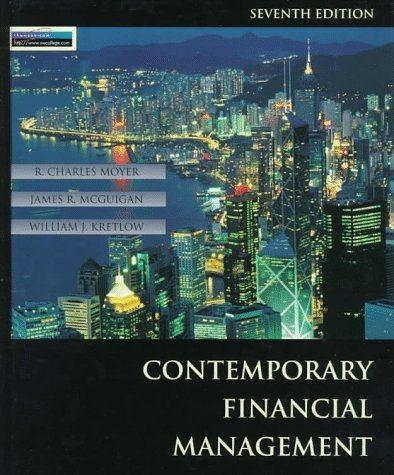Question
You have just graduated from the MBA program of a large university, and one of your favorite courses was Todays Entrepreneurs. In fact, you enjoyed
You have just graduated from the MBA program of a large university, and one of your favorite courses was Todays Entrepreneurs. In fact, you enjoyed it so much you have decided you want to be your own boss. While you were in the masters program, your grandfather died and left you $1 million to do with as you please. You are not an inventor, and you do not have a trade skill that you can market; however, you have decided that you would like to purchase at least one established franchise in the fast-foods area, maybe two (if profitable). The problem is that you have never been one to stay with any project for too long, so you figure that your time frame is 3 years. After 3 years you will go on to something else. You have narrowed your selection down to two choices: (1)Franchise L, Lisas Soups, Salads & Stuff, and (2)Franchise S, Sams Fabulous Fried Chicken. The net cash flows that follow include the price you would receive for selling the franchise in Year 3 and the forecast of how each franchise will do over the 3-year period. Franchise Ls cash flows will start off slowly but will increase rather quickly as people become more health-conscious, while Franchise Ss cash flows will start off high but will trail off as other chicken competitors enter the marketplace and as people become more health-conscious and avoid fried foods. Franchise L serves breakfast and lunch, whereas Franchise S serves only dinner, so it is possible for you to invest in both franchises. You see these franchises as perfect complements to one another: You could attract both the lunch and dinner crowds and the health-conscious and not-so-health-conscious crowds without the franchises directly competing against one another.
Here are the net cash flows (in thousands of dollars):
| Expected Net Cash Flows | ||
| Year | Franchise L | Franchise S |
| 0 | ($100) | ($100) |
| 1 | 10 | 70 |
| 2 | 60 | 50 |
| 3 | 80 | 20 |
Depreciation, salvage values, net working capital requirements, and tax effects are all included in these cash flows.
You also have made subjective risk assessments of each franchise and concluded that both franchises have risk characteristics that require a return of 10%. You must now determine whether one or both of the franchises should be accepted.
Question: Please show all your work including formulas in excel if used.
You are also considering another project that has a physical life of 3 yearsthat is, the machinery will be totally worn out after 3 years. However, if the project were terminated prior to the end of 3 years, the machinery would have a positive salvage value. Here are the projects estimated cash flows:
| Year | Initial Investment and Operation Cash Flows | End of Year Ned Salvage Value |
| 0 | -5000 | 5000 |
| 1 | 2100 | 3100 |
| 2 | 2000 | 2000 |
| 3 | 1750 | 0 |
Using the 10% cost of capital, what is the projects NPV if it is operated for the full 3 years? Would the NPV change if the company planned to terminate the project at the end of Year 2? At the end of Year 1? What is the projects optimal (economic) life?
Step by Step Solution
There are 3 Steps involved in it
Step: 1

Get Instant Access to Expert-Tailored Solutions
See step-by-step solutions with expert insights and AI powered tools for academic success
Step: 2

Step: 3

Ace Your Homework with AI
Get the answers you need in no time with our AI-driven, step-by-step assistance
Get Started


